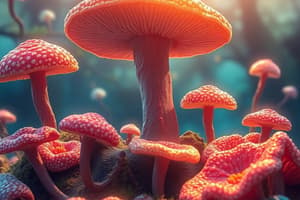Podcast
Questions and Answers
Which yeast is the causative agent of candidiasis?
Which yeast is the causative agent of candidiasis?
- Histoplasma spp
- Mycetoma
- Candida albicans (correct)
- Cryptococcus neoformans
In which sites are pathogenic Candida usually found in humans?
In which sites are pathogenic Candida usually found in humans?
- Mouth and vagina (correct)
- Intestines and digestive system
- Lungs and respiratory system
- Skin and external surfaces
What is the distinctive feature of Candida albicans' morphology?
What is the distinctive feature of Candida albicans' morphology?
- Formation of true hyphae (correct)
- Presence of pseudohyphae in cultures
- Growth as budding yeast cells
- Formation of chlamydosphores on nutritionally deficient media
How is Candida albicans identified in the laboratory?
How is Candida albicans identified in the laboratory?
What usually precedes invasive candidiasis?
What usually precedes invasive candidiasis?
How do non-albican Candida species enter the blood in majority of cases?
How do non-albican Candida species enter the blood in majority of cases?
What is the diagnostic feature used to identify Candida albicans?
What is the diagnostic feature used to identify Candida albicans?
Which of the following is a distinctive feature of Candida albicans' morphology?
Which of the following is a distinctive feature of Candida albicans' morphology?
What is the distinctive feature used to identify Candida albicans?
What is the distinctive feature used to identify Candida albicans?
What usually precedes invasive candidiasis?
What usually precedes invasive candidiasis?
How is Candida albicans identified in the laboratory?
How is Candida albicans identified in the laboratory?
What is the causative agent of candidiasis?
What is the causative agent of candidiasis?
Where are pathogenic Candida usually found in humans?
Where are pathogenic Candida usually found in humans?
What is the primary characteristic that distinguishes Candida albicans from other species?
What is the primary characteristic that distinguishes Candida albicans from other species?
What is the distinguishing feature of Candida albicans' morphology?
What is the distinguishing feature of Candida albicans' morphology?
How is Candida albicans identified in the laboratory?
How is Candida albicans identified in the laboratory?
What usually precedes invasive candidiasis?
What usually precedes invasive candidiasis?
Which yeast is the causative agent of candidiasis?
Which yeast is the causative agent of candidiasis?
Where are pathogenic Candida usually found in humans?
Where are pathogenic Candida usually found in humans?
What is the distinctive characteristic that distinguishes Candida albicans from other species?
What is the distinctive characteristic that distinguishes Candida albicans from other species?
How do non-albican Candida species enter the blood in the majority of cases?
How do non-albican Candida species enter the blood in the majority of cases?
(What are the majority of non-albican vagina species likely to enter the blood through?)
(What are the majority of non-albican vagina species likely to enter the blood through?)
What is the distinguishing feature of Candida albicans' morphology?
What is the distinguishing feature of Candida albicans' morphology?
What usually precedes invasive candidiasis?
What usually precedes invasive candidiasis?
Where are pathogenic Candida usually found in humans?
Where are pathogenic Candida usually found in humans?
What is the causative agent of candidiasis?
What is the causative agent of candidiasis?
Which yeast is the causative agent of candidiasis?
Which yeast is the causative agent of candidiasis?
How is Candida albicans identified in the laboratory?
How is Candida albicans identified in the laboratory?
Which characteristic distinguishes Candida albicans from other species?
Which characteristic distinguishes Candida albicans from other species?
What distinguishes the majority of non-albican vagina species from Candida albicans?
What distinguishes the majority of non-albican vagina species from Candida albicans?
How is Candida albicans identified in the laboratory?
How is Candida albicans identified in the laboratory?
What usually precedes invasive candidiasis?
What usually precedes invasive candidiasis?
What are the majority of non-albican vagina species likely to enter the blood through?
What are the majority of non-albican vagina species likely to enter the blood through?
What is a distinguishing feature of Candida albicans' morphology?
What is a distinguishing feature of Candida albicans' morphology?
What is the primary characteristic used for accurate identification of Candida species other than C. albicans?
What is the primary characteristic used for accurate identification of Candida species other than C. albicans?
Flashcards are hidden until you start studying
Study Notes
Candidiasis
- Candida albicans is the causative agent of candidiasis.
- Pathogenic Candida is usually found in humans in the following sites: skin, mucous membranes, and gastrointestinal tract.
Morphology of Candida albicans
- The distinctive feature of Candida albicans' morphology is the formation of germ tubes and chlamydospores.
- Germ tubes are long, branching tubes that form when Candida albicans is incubated in serum.
- Chlamydospores are large, thick-walled spores that are formed at the end of the germ tubes.
Laboratory Identification
- Candida albicans is identified in the laboratory by its ability to form germ tubes and chlamydospores.
- The germ tube test is a rapid and accurate method for identifying Candida albicans.
Pathogenesis
- Invasive candidiasis is usually preceded by colonization of the skin or mucous membranes.
- Non-albican Candida species enter the blood in the majority of cases through central venous catheters or other medical devices.
- Candida albicans can also enter the blood through the gastrointestinal tract.
Characteristics of Candida albicans
- The primary characteristic that distinguishes Candida albicans from other species is its ability to form germ tubes and chlamydospores.
- This characteristic is used for accurate identification of Candida albicans in the laboratory.
Studying That Suits You
Use AI to generate personalized quizzes and flashcards to suit your learning preferences.




